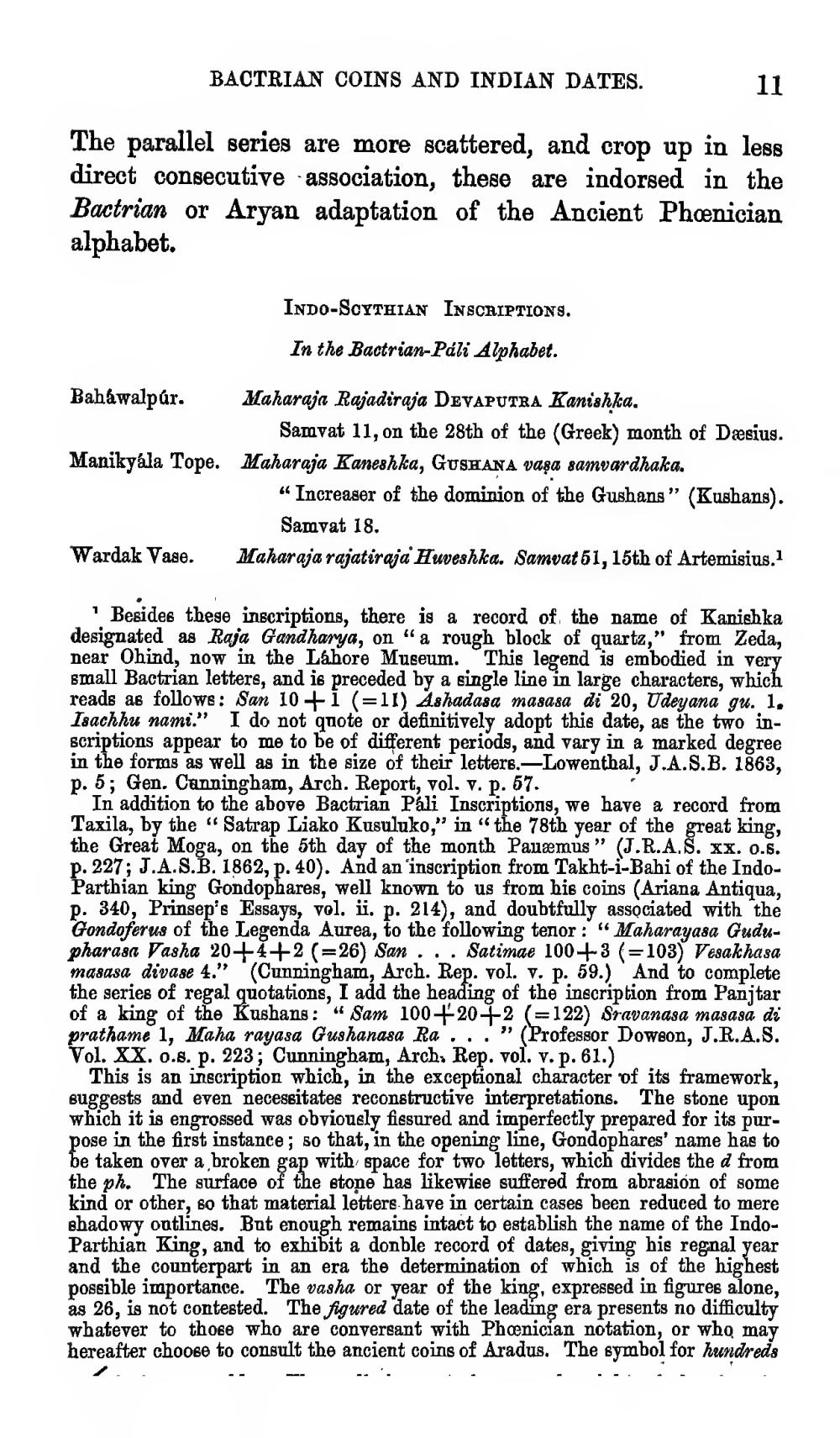________________
BACTRIAN COINS AND INDIAN DATES.
11
The parallel series are more scattered, and crop up in less direct consecutive association, these are indorsed in the Bactrian or Aryan adaptation of the Ancient Phoenician alphabet.
INDO-SCYTHIAN INSCRIPTIONS. In the Bactrian-Páli Alphabet.
Baháwalpúr. Maharaja Rajadiraja DEVAPUTRA Kanishka.
Samvat 11, on the 28th of the (Greek) month of Dæsius. Manikyála Tope. Maharaja Kaneshka, GUSHANA vaşa samvardhaka.
"Increaser of the dominion of the Gushans" (Kushans).
Samvat 18. Wardak Vase. Maharaja rajatiraja Heveshka. Samvat 51, 15th of Artemisius.1
1 Besides these inscriptions, there is a record of the name of Kanishka designated as Raja Gandharya, on "a rough block of quartz," from Zeda, near Ohind, now in the Labore Museum. This legend is embodied in very small Bactrian letters, and is preceded by a single line in large characters, which reads as follows: San 10+i(=11) Ashadasa masasa di 20, Udey ana gu. 1. Isachhu nami." I do not quote or definitively adopt this date, as the two inscriptions appear to me to be of different periods, and vary in a marked degree in the forms as well as in the size of their letters.-Lowenthal, J.A.S.B. 1863, p. 5; Gen. Cunningham, Arch. Report, vol. v. p. 57.
In addition to the above Bactrian Páli Inscriptions, we have a record from Taxila, by the Satrap Liako Kusuluko," in the 78th year of the great king, the Great Moga, on the 5th day of the month Pauæmus" (J.R.A.Š. XX. 0.5. p. 227; J.A.S.B. 1862, p.40). And an inscription from Takht-i-Babi of the IndoParthian king Gondophares, well known to us from his coins (Ariana Antiqua, p. 340, Prinsep's Essays, vol. i. p. 214), and doubtfully associated with the Gondoferus of the Legenda Aurea, to the following tenor: “Maharayasa Gudupharasa Pasha 20+4+2 (=26) San . . . Satimae 100+-3 (=103) Vesakhasa masasa divase 4." (Cunningham, Arch. Rep. vol. v. p. 59.) And to complete the series of regal quotations, I add the heading of the inscription from Panjtar of a king of the Kushans : “ Sam 100+ +2 (=122) Sravanasa masasa di prathame 1, Maha rayasa Gushanasa Ra..." (Professor Doweon, J.R.A.S. Vol. XX. o.s. p. 223; Cunningham, Arch. Rep. vol. v. p. 61.)
This is an inscription which, in the exceptional character of its framework, buggests and even necessitates reconstructive interpretations. The stone upon which it is engrossed was obviously fissured and imperfectly prepared for its purpose in the first instance; so that, in the opening line, Gondophares' name has to be taken over a broken gap with space for two letters, which divides the d from the ph. The surface of the stone has likewise suffered from abrasion of some kind or other, so that material letters have in certain cases been reduced to mere abadowy outlines. But enough remains intact to establish the name of the IndoParthian King, and to exhibit a donble record of dates, giving his regnal year and the counterpart in an era the determination of which is of the highest possible importance. The vasha or year of the king, expressed in figures alone, as 26, is not contested. The figured date of the leading era presents no difficulty whatever to those who are conversant with Phoenician notation, or who may
pobe to consult the ancient coins of Aradus. The symbol for hundreds




